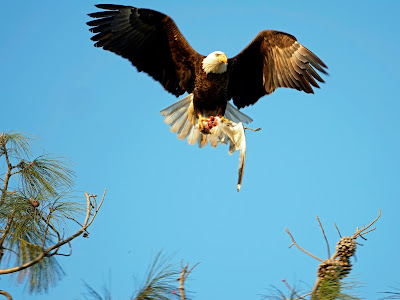Dale Matson
Click On Photographs To Enlarge
This year began slowly, with
photograph opportunities for mostly juvenile Bald Eagles and lately has ramped
up for many chances to photograph the mature Bald Eagles.
This is my third year attempting to
improve on my bird skills. Wildlife is so much more involved and difficult than
landscape photography. Both require patience and adequate preparation. Being a
former fisherman, I know how to wait. Even though my wildlife lens amounts to
560mm, it is almost always set at the maximum for eagles. Eagles in the wild
have a limited comfort zone. I am usually taking photos as I slowly approach
the birds because it is only a matter of time before they fly away.
Occasionally, they will let you get right under a tree in which they are
perched.
I have found that shutter priority is
my best camera setting. It is great to have image stabilization in my Sony A7R3
and in my Sony 100-400 GM lens (I use a 1.4X teleconverter also). I have never
had the opportunity nor have I seen the need for a tripod for eagles.
Morning seems to be the time they
are most active. The problem with long lenses is that most are not good in the
low morning light. Using a f 2.8 long lens means having lots of money and using
a tripod. They are not very portable. Much of the process is learning where
eagles like to go. I find living in Fresno CA that Millerton Lake and Eastman
Lake are convenient places to look. Both lakes are home to both resident pairs
of eagles and seasonal migration visitors. After three years, I am still
learning their favorite spots. Where are the Coots? There you may find an eagle. They also like peninsulas, dead trees and lakeshores with lots of
boulders.
This year I have used my 10X50
binoculars much more than in the past. My big lens is like a spotting scope but…it
uses battery life. Boat ramps are great places to drive down to and simply scan
the shoreline for birds.
This year I have become more
discerning about what is acceptable. Many of my shots have tree branches
covering a portion of the eagles but the head, eyes and beak must not be
obstructed. The pose is important also. I really like the shots where the bird
is launching off the branch to fly away.
I slow the shutter speed down for
birds that are perched so there is as much light and as low an ISO as possible.
I move around the tress to expose as much as possible of the bird in the
branches at the risk of the bird flying away. Sometimes getting closer means
more of the bird being covered by branches. A bird even in bright sunlight may
have the head in the wrong position creating shade over the eyes. Yesterday I
had 200 photographs of a pair of perched eagles. When I reviewed the
photographs, there were only a few where both birds had a good head position
and good lighting on the eyes. They eventually both flew away. Both the birds
and I had been there long enough. I think they know me when I show up or when I
am sitting there and they show up. What a joy it is for me.





















No comments:
Post a Comment